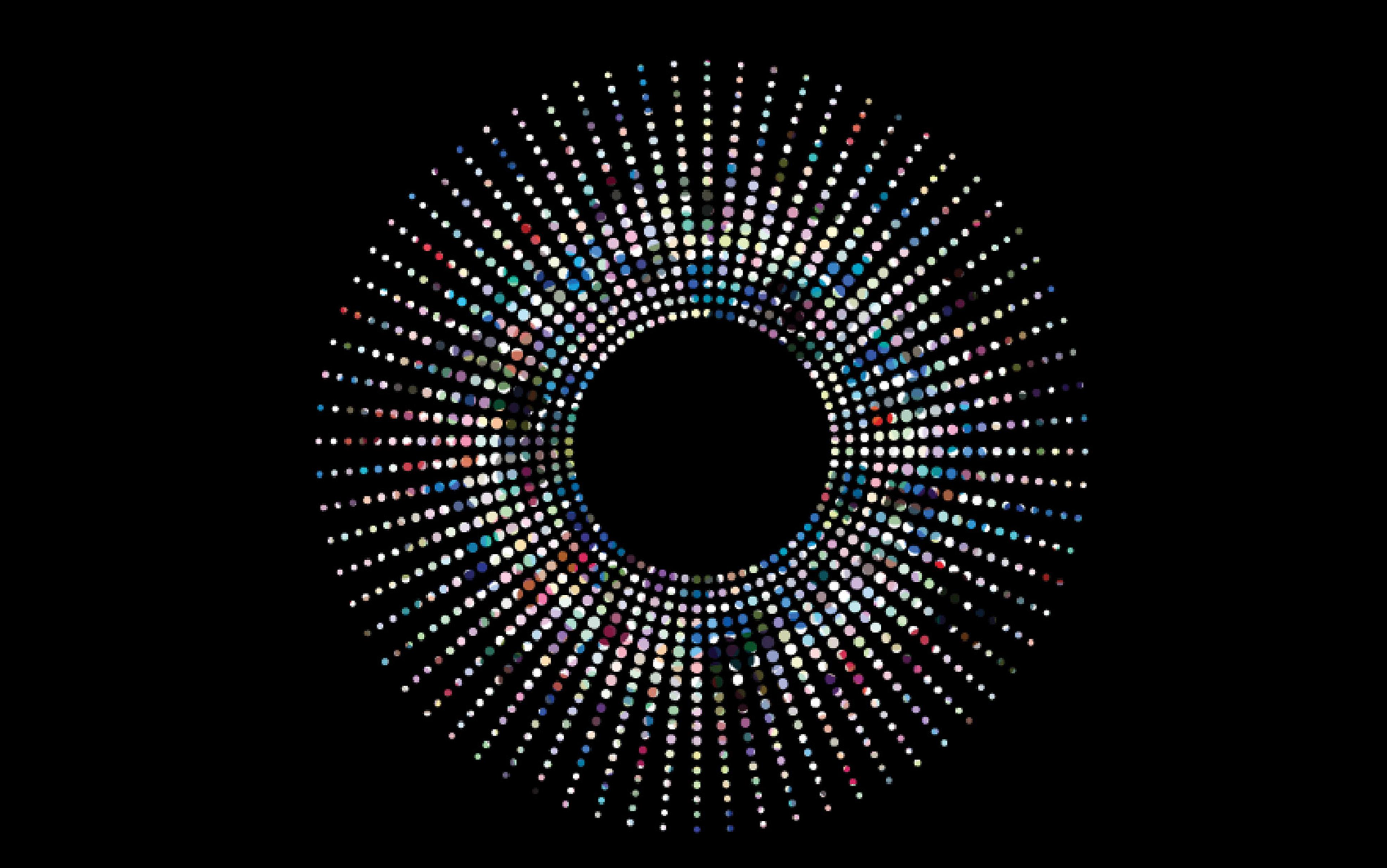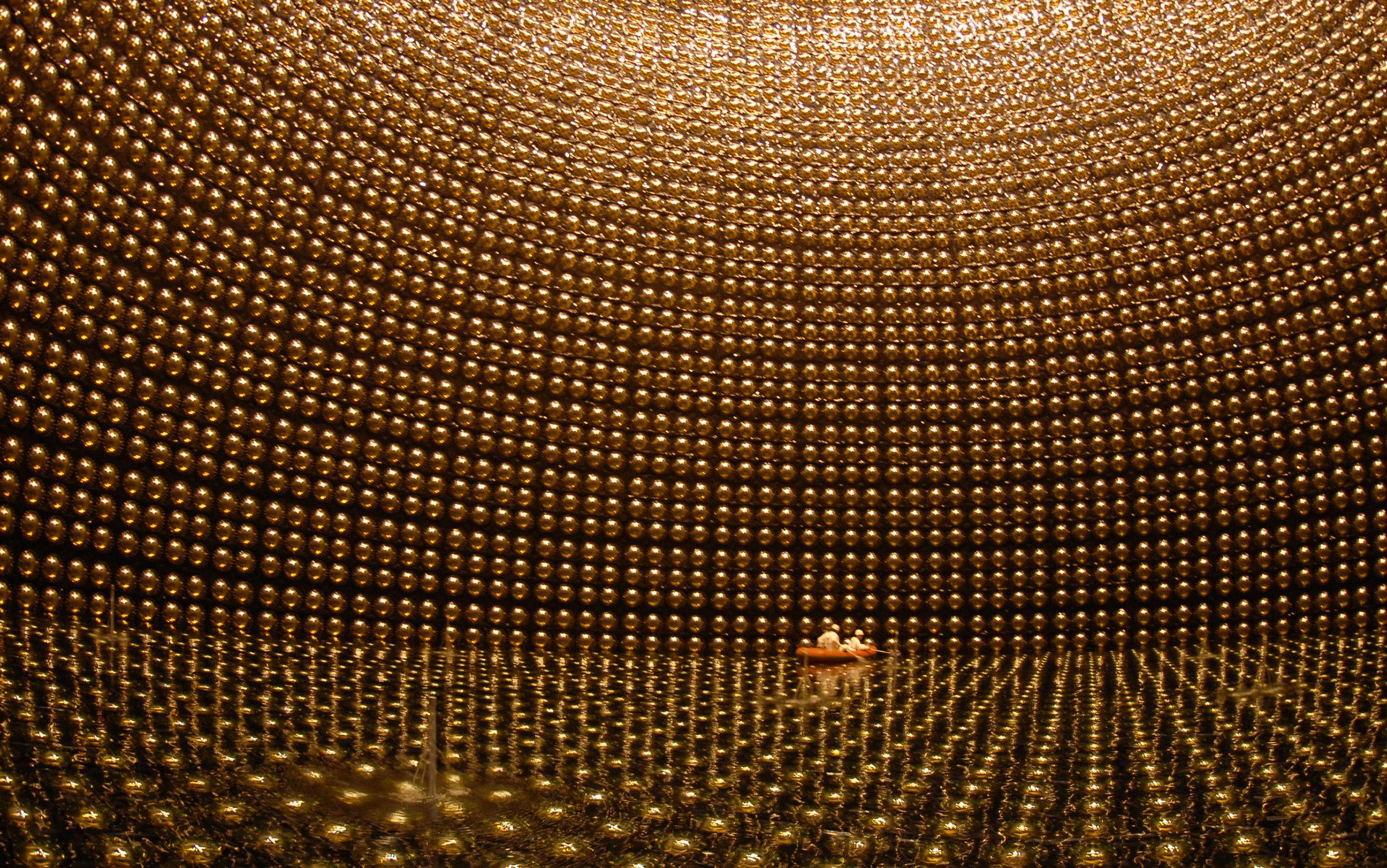Every fraction of a second, invisible particles called neutrinos whiz past the vans and Winnebagos on Highway 169 headed toward McKinley Park in northeastern Minnesota, just shy of the Canadian border. Having begun their journey at Fermilab, an imposing physics laboratory outside Chicago, some of those speeding neutrinos smack into 5-ton slabs of steel within an underground mine in the town of Soudan, Minnesota (population: 446), sending sparks of charged particles arcing toward sensitive detectors. Quite unlike the camper vans and RVs, the neutrinos complete their journey – 735 kilometres across the Upper Midwest – in less than three thousandths of a second.
Neutrinos are fundamental to the construction of the Universe. They are tremendously abundant, outnumbering atoms by about a billion to one. They modulate the reactions that cause massive stars to explode as supernovas. Their properties provide clues about the laws governing particle physics. And yet neutrinos are among the most enigmatic particles, largely due to their reticent nature: they have no electric charge and practically no mass, so they interact only extremely weakly with ordinary matter. Some 65 billion of them stream through every square centimetre of your body – an area the size of a thumbnail – every second, without your ever noticing them.
Through elaborate sleuthing, physicists have identified three distinct types of neutrinos, which differ in their subtle interactions with other particles. Stranger still, the neutrinos can ‘oscillate’ between types, shedding one identity and adopting another as they travel through space. That discovery led to a significant expansion of the standard theory of how particles behave. Now neutrinos and their subtle oscillations have helped physicists prove an even deeper mystery of matter.
Colleagues and I at the Massachusetts Institute of Technology (MIT) have recently used data on the detection of neutrinos in the Soudan mine to complete one of the longest-distance tests of quantum mechanics ever conducted. In scarcely more than half a century, neutrinos have gone from wispy, exotic particles at the edge of detectability to tools for investigating matter at its most essential – from prize-worthy quarry to something more like a forensics kit. In retracing that transformation, we catch glimpses of a larger story, of physicists groping toward an abstruse, beguiling account of nature, set against (and at times engulfed by) larger dramas of the nuclear age.
The discovery of the neutrino dates back to the 1930s, when the famed Italian physicist Enrico Fermi helped to hammer out the first workable theory of nuclear phenomena such as radioactive decay. To make his calculations work – in essence, as a bookkeeping device to ensure that all the energy entering a nuclear reaction would balance all the energy at the end – Fermi’s colleague Wolfgang Pauli had postulated the existence of a new, undetected particle that carried some of the energy away. Fermi developed the idea more fully and dubbed the mystery particle a neutrino, or ‘little neutral one’, since it was theorised to carry no electric charge.
Neither Fermi nor anyone else at the time thought that such tiny wisps of matter could ever be detected directly. Before long, the spread of fascism in Europe overshadowed any such lofty thoughts. As nations mobilised for war, physicists on all sides of the conflict were absorbed into top-secret projects. Meanwhile, the introduction of Nazi-inspired racial laws in Italy put Fermi’s family in danger (Fermi’s wife, Laura, was Jewish). In 1938, he managed a Sound-of-Music-like escape, exploiting a trip to Stockholm to accept the Nobel Prize in order to slip out of Europe and head for the United States, where he became one of the early scientific leaders of the Manhattan Project. In December 1942, Fermi’s group in Chicago coaxed the first nuclear reactor to go critical, inducing controlled nuclear fission. Their reactor design was scaled up during the war to produce plutonium for atomic bombs.
By the time post-war research resumed, physics had undergone an enormous transformation. The bloodiest armed conflict in history had thundered to an end, punctuated by the use of nuclear weapons against the cities of Hiroshima and Nagasaki. Throughout much of the war, the hastily built laboratory at Los Alamos, New Mexico, had served as the main coordinating site for the Manhattan Project. After the war, the laboratory continued to focus on improving and expanding the nation’s nuclear arsenal, giving physicists a newfound level of prestige (and funding) in Western nations, the US in particular. In this new environment, the first serious effort to detect neutrinos began in Los Alamos in the early 1950s.
Inside the shaft, they would suspend a one-ton detector, so big that they nicknamed it ‘El Monstro’
Frederick Reines was a young physicist at the Los Alamos Laboratory, part of the team that tested new weapons at the Eniwetok Atoll in the middle of the Pacific Ocean. Returning from a series of bomb tests in late spring 1951, he fell into a discussion about neutrinos with Fermi, who was then visiting the lab. Reines realised that the above-ground nuclear blasts that he and his team were studying at places such as Eniwetok should produce enormous floods of neutrinos – so many that a wayward few of the particles might just be detectable.
Reines and another Los Alamos colleague, Clyde Cowan, convinced the laboratory director to let them conduct an experiment at an upcoming bomb test. They would first excavate a narrow tunnel near where the bomb would be detonated. Inside the shaft, they would suspend a one-ton detector, so big that they nicknamed it ‘El Monstro’. When the bomb went off, carefully sequenced electronics would release the detector, letting it fall freely while the enormous shockwave from the bomb rumbled through the surrounding earth. (If they had bolted their detector in place so close to the blast, the shockwave would have ripped it apart.) Moments later, after the shockwave had passed, the detector would land on a pile of feathers and foam rubber.
Buried at the bottom of the shaft, the device would be awash in neutrinos from the nuclear fireball. Sensitive electronics on the detector – a huge vat filled with a solution of toluene, an organic molecule usually found in paint thinners – would monitor for tell-tale flashes of light. A flash would indicate that one out of hundreds of trillions of neutrinos had struck some matter in the liquid and shaken loose a positron, the antimatter twin of the electron. Meanwhile, the physicists would have to wait several days, until the hazardous radioactivity on the surface had died down sufficiently, before they could return to ground zero, dig back down the 150-foot shaft, and retrieve their instrument.
While preparing for their bomb-based test, Reines and Cowan realised that they could also hunt for neutrinos in a far less dramatic way. With one more tweak to their protocol to better rule out spurious readings, they could install their liquid-filled detector next to a nuclear reactor rather than beneath an exploding bomb. The two researchers ran a pilot test near one of the huge reactors in Hanford, Washington, super-sized versions of Fermi’s original reactor. Satisfied with the results, they installed an improved device at the newer, more powerful reactor at Savannah River, in South Carolina, during late 1955. (The Savannah River plant was built to produce tritium for hydrogen bombs, thousands of times more destructive than the original nuclear bombs.) Within months, Reines and Cowan had clocked in enough tiny flashes of light to convince their colleagues – and, in time, the Nobel Prize committee – that they had finally caught sight of the elusive neutrino.
Fermi’s former assistant Bruno Pontecorvo followed these developments with particular interest. Pontecorvo had begun his career in the 1930s as the youngest member of Fermi’s group in Rome; older members nicknamed him the ‘Puppy’. He immersed himself in the esoterica of nuclear physics, including Fermi’s new theory of radioactivity and the still-emerging, and still-hypothetical, ideas about neutrinos. Coming from a large Jewish family, Pontecorvo eventually found his situation in Italy untenable. His flight from fascism was even more dramatic than Fermi’s, closer to Casablanca than The Sound of Music: first a fellowship to study in Paris, then a harrowing, night-time escape through the countryside in June 1940, as Nazi tanks rolled into the city. From the south of France, Pontecorvo boarded a train to Madrid and then on to Lisbon before catching a steamship to New York City.
Once in the US, Pontecorvo, too, began working on the Manhattan Project. He was assigned to one of the British contingents working in Montreal, aiming to perfect a different type of nuclear reactor from Fermi’s in Chicago. After the war, he took a position with the new British nuclear research facility in Harwell, near Oxford, to continue his research on reactors. Around that time, he proposed a scheme to try to detect neutrinos streaming out of a nuclear reactor, years before Reines and Cowan independently pursued the idea.
Two fascinating books – Simone Turchetti’s The Pontecorvo Affair (2012) and Frank Close’s Half-Life (2015) – document the next bizarre twists in his life story. Pontecorvo had been named as one of the inventors, together with Fermi and other members of the Rome group, on a patented technique to slow down certain nuclear particles, and thereby increase the rate of particular nuclear reactions. The technique proved to be pivotal to wartime studies of nuclear fission, both for reactors and for bombs. After the war, the patents, which had been granted in Italy in 1935 and in the US in 1940, assumed a radically different patina.
In 1949, other members of the Rome group sought compensation for their patented technique, which had since been built directly into the sprawling infrastructure of the US nuclear complex. The patent-wrangling triggered an FBI investigation, which dredged up long-forgotten material on several of Pontecorvo’s relatives who had been outspoken communists in Italy. A few weeks later, Klaus Fuchs, one of Pontecorvo’s colleagues at Harwell, confessed to having passed atomic secrets to the Soviets during the war. Like Pontecorvo, Fuchs was an émigré from the Continent who had served as part of the British delegation on the Manhattan Project. The associations suddenly looked suspicious.
What came next reads like a Le Carré novel. While vacationing in Italy in early September 1950, Pontecorvo and his family abruptly zigzagged from Rome to Munich to Stockholm, then on to Helsinki, where they met up with Soviet agents. Pontecorvo’s wife and young children got into one car while Pontecorvo climbed into the trunk of another, and the secret caravan drove through the forest into Soviet territory. Hours later, the group arrived in Leningrad; within days they had been delivered to Moscow. Weeks went by before the UK or US authorities caught on. Finally, the US Joint Congressional Committee on Atomic Energy released a thick report on ‘Soviet Atomic Espionage’, proclaiming Pontecorvo’s defection to be only slightly less damaging than Fuchs’s disloyalty, and even worse than the alleged espionage for which Ethel and Julius Rosenberg would later be executed.
While lurid headlines swirled in the UK and the US, Pontecorvo settled into a new position at the vast nuclear research facility at Dubna, outside Moscow. As Close reveals, based on scrutiny of Pontecorvo’s personal notebooks from the time, Pontecorvo did consult on aspects of the secret Soviet nuclear weapons project, at least for a while. But soon he was given space to pursue more basic research as well. Upon learning of Reines’s and Cowan’s discovery, his thoughts returned to his longstanding love, the neutrino.
Fluid, uncertain identities had no easy place at the time of the McCarthy-era investigations
In 1957, Pontecorvo published an article in the leading Soviet physics journal suggesting that neutrinos could oscillate among different varieties, or ‘flavours’. He refined this idea in a series of papers, reasoning from quantum theory that the neutrinos should occur in overlapping states, neither in one flavour state nor the other but both. Any time they made a measurement, physicists should find a given neutrino in one state only. But in between observations, the neutrinos would not have a fixed identity. They would live in a state of statistical indeterminacy, partly one flavour and partly the other.
How stark the contrast must have seemed between the quantum world and the rules of human affairs. Fluid, uncertain identities had no easy place at a time when McCarthy-era investigators pressed: ‘Are you now or have you ever been…?’ Yet Pontecorvo himself had ricocheted among several distinct identities in rapid order, from the young ‘Puppy’ of Fermi’s group in Rome to ‘Academician Bruno Maximovitch Pontecorvo’ for the KGB.
One of the earliest dividends of Pontecorvo’s theory concerned physicists’ understanding of the Sun. The core of the Sun is a massive nuclear reactor, and theories of nuclear physics yielded a highly precise prediction of the neutrino flux that the Sun should produce. However, more sensitive follow-up experiments to the original Reines-Cowan test had found only about one third the expected number of solar neutrinos. During the early stirrings of US-USSR détente in the late 1960s, Pontecorvo was able to share his latest ideas directly with colleagues in the West. He now calculated that neutrinos should oscillate among three distinct flavours. If so, the solar neutrino detectors, which were only sensitive to one of the flavours, should register the readings of the neutrino flux that the experimentalists kept finding.
Years’ more data confirmed the pattern, and eventually convinced the skeptics. Even so, the solar-neutrino readings provided only indirect evidence that neutrinos oscillate. The next challenge was to try to catch them in the act. Groups around the world built ever-bigger detectors buried deep underground, ultimately growing thousands of times larger than Reines’s and Cowan’s original design. During the late 1990s and early 2000s, teams at the Super-Kamiokande facility in Japan, and separately at the Sudbury Neutrino Observatory (SNO) in Ontario, Canada, amassed compelling evidence of neutrino oscillations. The existence of oscillations indicated that neutrinos could not be massless particles, as was predicted by the prevailing theory of the time.
The origin and nature of neutrino mass remains a major ongoing area of exploration. Physicists also continue to test whether only three flavours of neutrinos exist in nature. Any more than three would provide decisive evidence that the Standard Model of particle physics – a theory which has successfully described every experiment involving elementary particles for more than forty years – is incomplete.
The Super-Kamiokande and SNO projects netted the Nobel Prize for the physicists Takaaki Kajita and Arthur McDonald, the leaders of the two groups, in October 2015. Three weeks later, the annual Breakthrough Prize in Fundamental Physics disbursed $3 million among the nearly 1,400 physicists who had worked on the teams. My friend and colleague at MIT, Joe Formaggio, a member of the SNO collaboration, used his share of the prize money to buy a nice bottle of wine – something a few price points north of his usual purchases.
Research on neutrinos seems more exciting than ever these days, offering a tantalising route to explore beyond the Standard Model. My own interest in these particles was sparked in a different way, however. It came about when Joe suggested that we might put neutrinos to work in a different way: to test one of the central tenets of quantum mechanics, the prevailing theory of matter at its most fundamental.
For nearly a century, physicists have deployed the theory of quantum mechanics to make sense of atoms and the parts of atoms. Although the theory’s predictions have never failed to match experiments, quantum mechanics has a host of bizarre-sounding features. Back in the 1920s and ’30s, for example, the Danish physicist Niels Bohr argued that, according to quantum theory, particles do not have definite values for various properties until they are measured – as if a person had no particular weight until stepping on a scale. Moreover, quantum theory seemed to provide only probabilities for various events, rather than the rock-solid predictions that flowed from Isaac Newton’s laws of gravity or Albert Einstein’s relativity.
By 1935, just as Fermi’s attention turned to the tiny neutrino and efforts to understand nuclear reactions within the framework of quantum theory, Einstein and his colleague Erwin Schrödinger had decided that quantum theory itself was suspect. In letters that summer, they egged each other on, grasping for some way to convince their colleagues that even in a strange world (a blood-soaked world that too often strained logic and reason), quantum theory was simply too strange. By that time both had fled Nazi Germany: Einstein had resettled in leafy Princeton, New Jersey, and Schrödinger had moved to Oxford, before settling in Dublin.
Their spirited exchange yielded one of the most famous thought experiments in physics, known as ‘Schrödinger’s cat’. Imagine a cat inside a windowless box. Next to the cat, a scheming physicist has placed some radioactive material. According to the probabilistic laws of quantum theory, that material has a 50-50 chance of decaying within a given period of time: the next hour, say. If the material does decay, a detector inside the box will register the radioactivity and release a hammer that will smash a vial of cyanide, killing the cat. If the radioactive source does not decay within the allotted time-frame, the poison will remain bottled up and the cat will live.
Schrödinger’s challenge might strike us as equal parts Rube Goldberg contraption and an episode from The Walking Dead, but his target was the heart of quantum theory itself. Before the physicist opened the box and observed whether the cat was alive or dead, Bohr’s beloved quantum theory could only describe the cat as suspended in a superposition, neither alive nor dead but alive-and-dead – a kind of hybrid, zombie state, a mixture of opposites that we never observe in our ordinary affairs.
Schrödinger and Einstein considered such conclusions nonsense. They insisted that any reasonable physics theory should be able to ascribe a single, definite value to the cat’s aliveness at any particular moment. Both physicists feared that mumbling about superpositions was a form of epistemological surrender, abdicating physicists’ long-term goal of describing nature in precise and predictive ways. Yet Bohr remained unfazed. He insisted that quantum theory pointed to ways of being in the world that simply were different than what our human-scale experience had led us to expect. If the equations of quantum theory featured these superposition states – matter behaving as ‘both-and’ rather than ‘either-or’ – then physicists would need to accommodate their thinking to such spooky features. Superposition came to be seen as a hallmark of quantum behaviour.
The probability of detecting a particular flavour of neutrino spreads out through space and time like a wave
According to quantum theory, neutrinos’ flavour-changing ways are directly analogous to Schrödinger’s half-dead/half-alive cat, making neutrino oscillations a powerful way to explore the validity of superposition. My colleague Joe Formaggio realized that we could analyze how the mix of neutrino flavours changes as the particles travel, finally settling into a single flavour (equivalent to a definitive verdict of a ‘dead’ or ‘alive’ cat) when measured. Together with two marvelous students – undergraduate Talia Weiss and the graduate student Mykola Murskyj – Joe and I set out to investigate.
Pontecorvo’s theory of neutrino oscillations, based squarely on the notion of quantum superpositions, provides an excellent match to the latest experimental data. But, we wondered, could the same data be compatible with alternative theories? Perhaps a theory more like the type that Einstein and Schrödinger had held out hope for – in which superpositions are absent, and particles always possess definite properties at each instant of time – could account equally well for the data. Formaggio’s key insight was that if neutrinos are truly governed by quantum superposition – if they zoom through space as ‘both-and’ rather than ‘either-or’ – then the likelihood of detecting a particular flavour at a specific location should be quantitatively different than it would be if each neutrino possessed a definite identity at any given moment and merely oscillated among distinct identities over time.
Though our analysis became a bit baroque, in essence it boiled down to a simple observation. According to quantum mechanics, the probability of detecting a particular flavour of neutrino spreads out through space and time like a wave. The wave associated with one neutrino flavour evolves with a slightly different frequency than the wave for another flavour. For a neutrino in a superposition state, those not-quite-identical waves can interfere with each other, in much the way that overlapping waves can interfere with each other on the surface of a pond. At some points along the neutrino’s journey, the crests of each probability wave will align, while at others the crest from one wave will cancel out a trough from another.
All of this leads to a directly detectable effect. Where crests meet, the probability to detect a particular flavour rises; where crests cancel troughs, that probability falls. Moreover, the interference pattern – those spots where crests add with crests – should shift with the neutrino’s energy. On the other hand, in rival theories that lack superposition, such as those sought by Einstein and Schrödinger, no such interference pattern should occur. We calculated the different patterns predicted for the number of neutrinos that should be detected in a given flavour as one varied their energy, depending on whether the neutrinos made their journey in a superposition state or not. Then we compared these calculations with data from the Main Injector Neutrino Oscillation Search (MINOS), an experiment that has been shooting beams of neutrinos from Fermilab toward the Soudan mine in Minnesota since 2005.
Not only did the quantum-mechanical calculation match the MINOS data beautifully, but the Einstein-like version didn’t come close. Even taking into account the uncertainties and statistical flukes that can skew experimental results, we found the odds that the neutrinos were genuinely governed by an Einstein-like theory of matter, with no superpositions, to be less than one in a billion.
Quantum effects like superposition are usually only manifest over incredibly short distances of tens or hundreds of nanometers, but our test demonstrated unmistakable quantum strangeness over a span of 735 kilometres. And that may be just the beginning. The world is awash in neutrinos that have traveled 150 million kilometres from the Sun, and cutting-edge experiments like the IceCube Neutrino Observatory at the South Pole can now detect primordial neutrinos that have been traveling through space for billions of years, ever since the Big Bang. Perhaps neutrinos like these can also be coaxed to reveal tell-tale signs of quantum superposition. Then we could test this central feature of quantum theory across the vastness of cosmic distances.
In the meantime, by puzzling through the strange dance of oscillating neutrinos, my colleagues and I have found that, for all of the apparent fairytale strangeness of quantum mechanics, its predictions hold up at human scales. Perhaps it is fitting that the neutrinos’ journey from Fermilab to the Soudan mine is about the same distance that Pontecorvo himself traveled during his storied lifetime, bounding from Rome to Paris or sneaking from Helsinki to Moscow. Across distances like these, we can say with confidence that we really do live in a world of strange superpositions.






